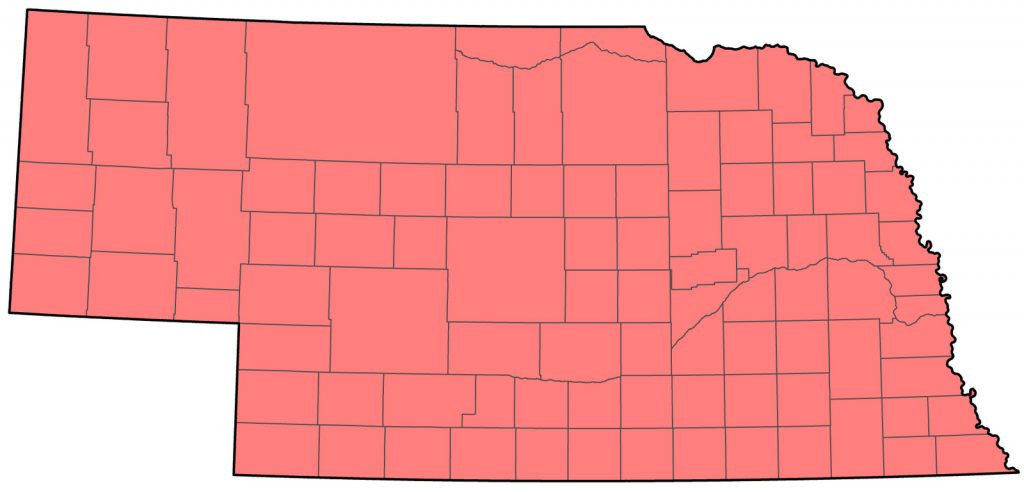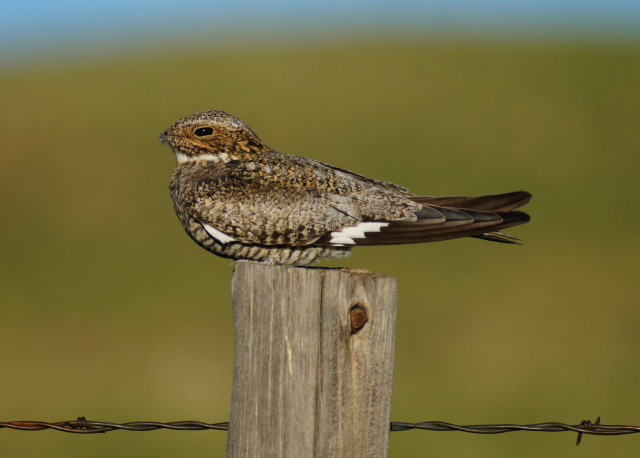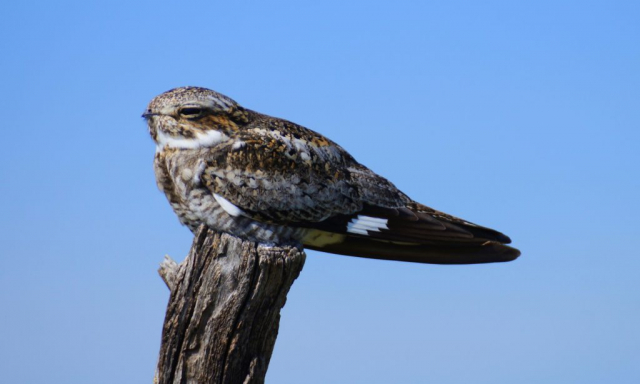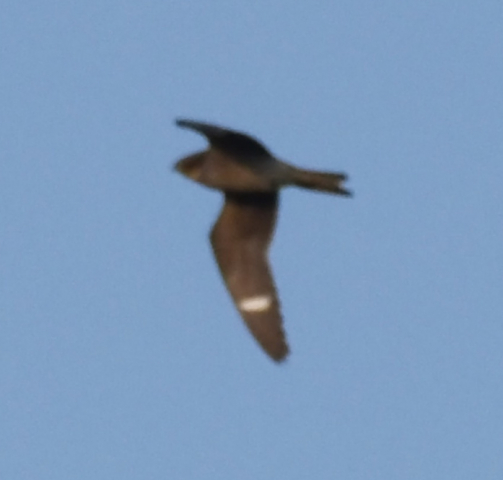Chordeiles minor minor, C. m. sennetti
Status: Common regular spring migrant statewide. Common regular breeder statewide. Abundant regular fall migrant statewide.

Documentation: Specimen: minor, UNSM ZM 10632 Child’s Point, Sarpy Co 22 May 1911; sennetti, UNSM ZM6253 Indian Creek, Sioux Co 5 Jul 1901.
Taxonomy: Nine subspecies are recognized, seven in North America (AviList 2025). The northern subspecies are minor of central and southern Canada and the eastern USA, hesperis of southwest Canada and the western USA, sennetti of south-central Canada and central and north-central USA, howelli of the west-central USA, henryi of the southwest USA and north-central Mexico, aserriensis of southeast Texas and northeast Mexico, and chapmani of the southeast USA.
The northeastern USA subspecies minor is known to occur westward to central Nebraska (AOU 1957) but may currently occur further westward as an urban dweller nesting on flat, gravelly rooftops. The state’s open grasslands (most of the state except for the east) are occupied by the smaller and paler plains subspecies sennetti (Haecker et al 1945, AOU 1957).
Bruner et al (1904) stated that a “rufous” form occurred only in ponderosa pine parkland in Sioux Co, referring to it as henryi. Zimmer (1913) stated that at the Thomas County Forest Reserve on 30-31 Aug 1911 he saw “several nighthawks so conspicuously rufous that I am inclined to think they were,,, henryi, which breeds to the north and west … in the Pine Ridge region and spreads eastwards during migration”. AOU (1957) and Brigham et al (2020) describe the range of henryi as breeding in mountains of southern Colorado southward. Another possibility is howelli; its range is described by Brigham et al (2020) as “Breeds in southern Great Plains from central Colorado and w. Kansas south to ne. New Mexico…”, and AOU (1957) cites a similar distribution; neither would include Nebraska, but this range is closer to Nebraska than that of henryi. Intriguingly, Swenk (1919) described howelli as an “uncommon breeder in extreme southwest [Nebraska]”. Pyle (1997) described henryi as having a “cinnamon appearance”.
The western subspecies hesperis has occurred in Hamilton, Kansas (AOU 1957), suggesting that western forms might indeed reach Nebraska.
There are two recent reports of brown Common Nighthawks: one at Ash Hollow SHP, Garden Co 2 Sep 2020 was more brown than gray and had extensively spotted under wing coverts, fitting the description of henryi (Mlodinow, eBird.org), and photographs of an overall evenly brown individual at Crescent Lake NWR, Garden Co 9 Jun 2021 (Mlodinow, eBird.org) were convincing for subspecies henryi or howelli. A photo of the latter bird is attached to the 2021 account. In 2023, a smaller, browner nighthawk, possibly subspecies henryi, was “chased mercilessly” by three larger, grayer nighthawks near Pine Bluffs in Kimball Co 17 Jun.
It is possible that habitat changes since about 1950 have significantly altered subspecific distribution. Mays et al (2019) stated “habitat fragmentation due to agricultural expansion resulting in population isolation” had occurred in their study area in South Dakota and Nebraska; Common Nighthawks nest on gravel rooftops in urban areas isolated from other urban areas by surrounding agricultural landscapes that have replaced the original grasslands thus restricting gene flow. These authors found through genetic analyses that there was indeed a clear lack of mixing of the haplotypes occurring in the four urban areas sampled, although the authors did not discuss possible relevance of their data to subspecies distribution.
Spring: May 1, 1, 1 <<<>>> summer (east), May 7, 8, 9 <<<>>> summer (central), May 15, 16, 16 <<<>>> summer (west)
In the Panhandle, arrival is in mid-May, although there are undocumented earlier reports 18 Apr 1995 at Crescent Lake NWR, Garden Co, 3 May 2012 there also, and 10 May 2023 Box Butte Co.
Arrival is earlier in the east than in the west; this interval has been estimated at about two weeks (Gates 1966), and may be related to different subspecies, with eastern minor perhaps arriving earlier than western and central sennetti. The same two-week difference is seen in Fall (see Fall below).
Concentrations of spring migrants are rarely seen, although 31 in Kimball Co 5 Jun 2005 and 30 over Omaha, Douglas Co 2 May 2025 were likely migrants.
- High counts: 31 in Kimball Co 5 Jun 2005, 30 over Omaha, Douglas Co 2 May 2025, 27 in Lincoln, Lancaster Co 21 May 2024, and 24 at Exit 1 on I-80, Kimball Co 28 May 2024.
Summer: BBS data indicate that the greatest numbers occur in grasslands of the north and north central, and fewest occur in the east. The latter may be an artifact resulting from the tendency for BBS routes to undercount urban habitats, the preferred habitat for this species in the east, or the tendency for grassland birds to fly and sit on fenceposts during daylight hours.
- Breeding Phenology:
Eggs: 29 May- 3 Aug (Mollhoff 2022).
A nest with eggs was near Keystone, Keith Co early Aug 1981 (Rosche 1994). - High Counts: 70 in Box Butte Co 7 Jun 2008, and 25 at Gilbert-Baker WMA, Sioux Co 9 Jun 2023.
Fall: summer <<<>>> Sep 22, 23, 24 (west), summer <<<>>> Sep 26, 27, 28 (central), summer <<<>>> Oct 11, 11, 11 (east)
Later dates include in the east 18 Oct 2009 Otoe Co, central 8 Oct 2021 Dawson Co, 9 Oct 2024 Buffalo Co, 16 Oct 2016 Lincoln Co, and 17 Oct 2018 Buffalo Co, and west 4 Oct 2010 Dawes Co, and 6 Oct 2024 Scotts Bluff Co. A date of 24 Oct without year or location is cited in Johnsgard (1980).
Large aggregations are often seen in fall, beginning in mid-Aug, although a “nice flock” was over Lincoln 30 Jul, and 35 were counted at Gordon, Sheridan Co, 27 Jul 2022. Departure is generally in Sep, and Oct records are few.
There is no clear difference in departure dates between the west and central, but dates in the east are about two weeks later, reflecting the spring differential.
- High counts: 1422 over Omaha 11 Sep 2013, 1000 over Bellevue, Sarpy Co 30 Aug 2016, 600 over Omaha 25 Sep 2006, 600 “possibly several thousand” over Bellevue 30 Aug 2016, “several hundred” at Scottsbluff, Scotts Bluff Co 23 Aug 1994, 350 in 15 minutes over Elkhorn, Douglas Co 27 Aug 2021, and 292 in 32 minutes over western Douglas Co 16 Sep 2012.
Abbreviations
BBS: Breeding Bird Survey
NWR: National Wildlife Refuge
UNSM: University of Nebraska State Museum
Images
Literature Cited
American Ornithologists’ Union [AOU]. 1957. The AOU Check-list of North American birds, 5th ed. Port City Press, Baltimore, Maryland, USA.
AviList Core Team, 2025. AviList: The Global Avian Checklist, v2025. https://doi.org/10.2173/avilist.v2025.
Brigham, R.M., J. Ng, R.G. Poulin, and S.D. Grindal. 2020. Common Nighthawk (Chordeiles minor), version 1.0. In Birds of the World (A. F. Poole, Editor). Cornell Lab of Ornithology, Ithaca, NY, USA. https://doi.org/10.2173/bow.comnig.01.
Bruner, L., R.H. Wolcott, and M.H. Swenk. 1904. A preliminary review of the birds of Nebraska, with synopses. Klopp and Bartlett, Omaha, Nebraska, USA.
Gates, D. 1966. Comparative arrival dates of selected migratory birds in selected counties in Nebraska. NBR 34: 66-69.
Haecker, F.W., R.A. Moser, and J.B. Swenk. 1945. Checklist of the birds of Nebraska. NBR 13: 1-40.
Johnsgard, P. A. 1980. A preliminary list of the birds of Nebraska and adjacent Great Plains states. Published by the author, University of Nebraska, Lincoln, USA.
Mays, S.E., G.N. Newberry, L. Riley, H.B. Britten, and D.L. Swanson. 2019. Common Nighthawks (Chordeiles Minor [sic]) in Agricultural Landscapes: Genetic Structure of Populations Restricted to Urban Rooftop Nesting, The American Midland Naturalist 181: 29-40. https://doi.org/10.1674/0003-0031-181.1.29.
Mollhoff, W.J. 2022. Nest records of Nebraska birds. Nebraska Ornithologists’ Union Occasional Paper Number 9.
Pyle, P. 1997. Identification Guide to North American Birds. Part I, Columbidae to Ploceidae. Slate Creek Press, Bolinas, California, USA.
Rosche, R.C. 1994. Birds of the Lake McConaughy area and the North Platte River valley, Nebraska. Published by the author, Chadron, Nebraska, USA.
Swenk, M.H. 1919. The Birds and Mammals of Nebraska. Contributions of the Department of Entomology No. 23. Lincoln, Nebraska.
Zimmer, J.T. 1913. Birds of the Thomas County Forest Reserve. Proceedings of the Nebraska Ornithologists’ Union 5: 51-104.
Recommended Citation
Silcock, W.R., and J.G. Jorgensen. 2025. Common Nighthawk (Chordeiles minor). In Birds of Nebraska — Online. www.BirdsofNebraska.org
Birds of Nebraska – Online
Updated 28 Jul 2025



